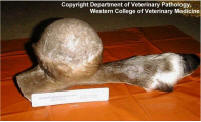|
|
| |
| Causative Agent |
-
A potentially
zoonotic disease of ungulates and
the carnivores that feed on them. Caused by the
bacteria
Brucella abortus and
Brucella suis type 4.
-
Brucella
bacteria generally cause
chronic infections.
|
| Images |
|
Click on image to enlarge. |
 |
|
Swollen knee joint of
caribou due to brucellosis. |
|
| Distribution |
|
Geographic: |
-
Brucella once occurred worldwide,
but now has limited distributions due to
government-sponsored eradication programs.
-
In Canada, there are two
forms of the disease associated with the two species of
bacteria listed above: specifically
in Wood Buffalo National Park, northeastern Alberta,
affecting primarily wood bison (B. abortus), and
barren-ground caribou and reindeer (B. suis type 4)
elsewhere.
-
There is no reported
occurrence of brucellosis in BC in any species. The greatest
risk is if an infected wood bison from Wood Buffalo National
Park disperses to northeastern BC and contacts a native or
captive bison population.
|
|
Seasonality: |
-
Risk of exposure increases prior to and during calving season due to the
presence of large numbers of
bacteria in fetal fluids.
|
|
| Hosts, Transmission and Life
Cycle |
|
Brucella abortus |
|
Hosts: |
-
Bison and potentially other
ungulates.
-
Sexually mature animals are
more susceptible than immature animals.
-
B. abortus
has also been found in wolves, fox and moose within Wood
Buffalo National Park, Alberta.
|
|
Transmission and Life Cycle: |
-
Transmission rates are greater in highly social animals.
-
Bacteria enter the body through
mucous membranes and are spread through the
lymph nodes and spleen.
-
If a pregnant animal is
infected, the
bacteria invades the uterus and
placenta, restricting the transfer of nutrients to the fetus
as well as producing toxins, potentially leading to fetal
death or the birth of an infected offspringfetus.
-
In social ungulates,
bacteria are spread from direct
contact with infected animals. This includes:
-
Carnivores are thought to be
exposed through the consumption of infected animals, the
placenta or aborted fetuses.
-
Moose are unusually
susceptible to B. abortus and often die of the
infection.
|
|
Brucella suis type 4 |
|
Hosts: |
-
Barren-ground caribou (Rangifer
tarandus) and reindeer (Rangifer
tarandus).
-
May also spill-over into wolves (Canis lupus), domestic dogs, and bears (Ursidae).
|
|
Transmission
and Life Cycle: |
-
Very similar to that of B. abortus except different species are
involved.
|
|
| Signs and Symptoms |
|
Wildlife: |
-
Wildlife may not show signs of the disease and instead appear healthy.
-
Signs of disease in infected animals vary according to species but are
primarily found in the reproductive tracts of both sexes. These
include:
-
inflammation of the testicles or uterus;
-
retained placentas;
-
fluid-filled swellings of
the forelegs.
-
abortion occurring during
late pregnancy;
-
calves that are born may be
weak.
-
Less commonly, infection
with Brucella
bacteria may cause
arthritis, formation of
abscesses in
lymph nodes, and
inflammation of mammary tissue.
|
|
Humans: |
-
Disease begins within a week or up to several months after exposure.
-
B. suis
type 4 elicits more serious effects in humans than B.
abortus.
-
Blood becomes infected and is accompanied by a fever. Symptoms
include:
-
chills;
-
profuse sweating;
-
weakness and fatigue;
-
joint pain.
-
Brucella
bacteria localize in the
lymph nodes and spleen.
-
If untreated, the disease
may persist from weeks to months with the potential for serious
effects on the brain, joints, bones or heart.
|
| Meat Edible? |
-
Do not cut into diseased parts or meat that has had fluid from the uterus
spilled on it.
-
Meat can be safely consumed if cooked thoroughly; however, freezing,
smoking, drying or pickling will not kill the
bacteria.
-
Brucella
bacteria may be found in the bone
marrow and liver.
-
Meat from an infected
carcass or a carcass thought to be infected
should NOT be fed
to domestic cats or dogs.
|
| Human Health Concerns and
Risk Reduction |
-
People at risk of contracting brucellosis include: abattoir workers,
veterinarians, farmers and wildlife personnel.
-
Hunters are not perceived as being at high risk of exposure to
Brucella
bacteria as the timing of hunting
relative to the breeding season limits exposure.
-
Humans may contract the
infection through inhalation, skin abrasions,
mucous membranes, or the
conjunctiva of the eyes when they
handle infected animals during activities such as:
-
butchering;
-
handling fetuses or
afterbirth;
-
contact with raw meat or the
secretions and excretions of the genital system;
-
ingestion of infected
animals.
-
Brucellosis is a
reportable disease in Canada, and under the Health of Animals Act, all cases must
be reported to the Canadian Food Inspection Agency (CFIA).
|
| Samples for Diagnosis |
-
Tissues to be collected for diagnosis include: lungs, stomach contents,
spleen (of fetus or calf), affected joints, reproductive tract, and
lymph nodes.
-
Appropriate safety
precautions (protective clothing, eyeware, gloves) should be used if
cutting into an animal suspected of being infected with Brucella
bacteria.
-
Hands, knives, clothes and
cutting surfaces should be thoroughly cleansed with hot soapy water
after handling an animal suspected of having the disease.
-
Immunological tests of live animals can
also determine the presence of Brucella
bacteria.
|
| Further Reading |
|
|
|
|




